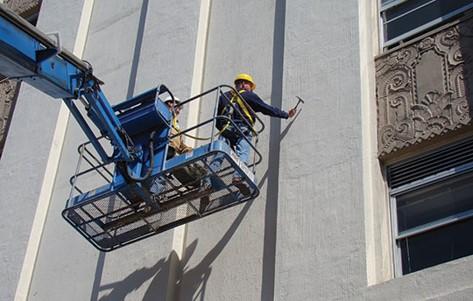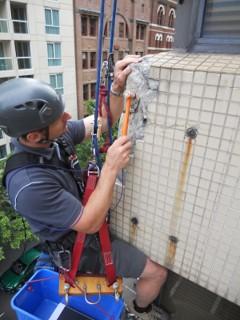Case 1
- Introduction
- Causes of Defects
- Good Practices
- Standards
- Maintenance and Diagnostics
- Remedial
- Similar Cases
- References
Maintenance and Diagnostics
Maintenance
Consider availability of adequate water supply, drainage provisions and electrical power supply to choose a façade cleaning method. Records of cleaning operations (including photographs before and after cleaning, and drawings of nature of deposits, thickness and patterns) should be kept for buildings of significance in accordance with BS 8221-1, SS 509-1 or equivalent. Maintain the façade in a state as near as possible to its new condition. Ease of façade maintenance can be expressed by the frequency of necessary maintenance operations, labour and supplies necessary for each maintenance operation,
and number of possible ways of removing stains, graffiti, etc., or ISO 7361 or equivalent.
Detect/determine staining of porous substrates by joint sealants (ISO/NP 16938-1). Adopt the recommendations for treatments for controlling organic growth in accordance with BS 8221-2,
SS509-2 or equivalent. Repair painted surfaces damaged by wear and tear; wash down; remove defective
paint film; apply sealer/primer (if necessary); and repaint in accordance with BS 6150, SS 542 or equivalent. TiO2 only works where there is sunlight. Conventional cleanings are still needed for non-coated areas. For areas coated with TiO2, conduct neutral cleaning annually.
- Masonry requires periodic maintenance to ensure its continued successful performance.
- Although the brick units are quite durable over time, other materials in the wall system will require periodic repair and/or replacement.
- Typical maintenance items which should be addressed are repairing of cracks in masonry, cleaning clogged weepholes, removing stains and efflorescence, repainting steel, replacing caps or copings, repointing mortar joints (tuck-pointing), replacing deteriorated sealants and caulking, and cleaning the masonry.
- Cleaning to external brickwall of public residential flats is rarely carried out.
- Scheduled repainting of once every five years is adequate in combating dirt stains and keeping the buildings in an acceptable state of cleanliness. Table 1 shows the cleaning method for each type of stain.
| Condition of Brick wall | Cleaning method |
| Dirt on brick Smooth textured bricksModerately rough textureVery rough textureWalls with coloured mortar joints | Scouring powder and a stiff brush. Where budget allows, high pressure steam with detergent allows faster cleaning. Scrubbing with an oxalic acid-ammonium biflouride solution Pressurized water cleaning Mild detergent solutions. Acids may bleach coloured mortar. |
| Biological stain | Apply sulpharnate or weed killer. |
| Green Stains from Vanadium salts | Flush brickwall with water followed by solution of potassium or sodium hydroxide. Allow it to stand for 3 days. Hose off remaining white salt on the brickwall from the hydroxide. |
| Paint on wall | Chemicals and high-pressure steam or scrubbing with steel. wool. |
| Walls with efflorescence | Generally disappear with normal weathering. Can be removed by dry brushing or with clear water and a stiff brush. Heavy accumulation requires proprietary cleaner. |
| Grayish- white haze (White scum) | Masking by solutions of paraffin oil and Varsol, or linseed oil and Varsol, applied by brush to the affected brick units. |
Table 1: Cleaning method for different types of stains.
Diagnostics of Defect (see also NDT)
Hammer Tapping Test
Tapping test may be used to detect hollowness, delamination, spalled or debonded plaster.by listening to the ‘void’ sound.



Moisture meter is used to determine the presence of moisture. Moisture readings can be taken within masonry walls, dry walls, insulation, concrete members, roofing, wood construction, and other building components.
